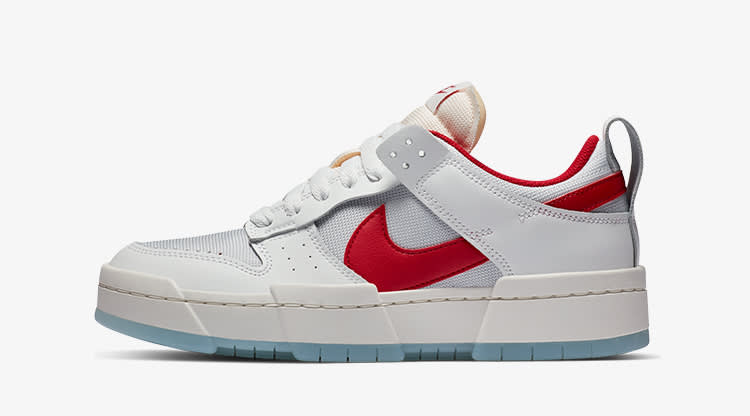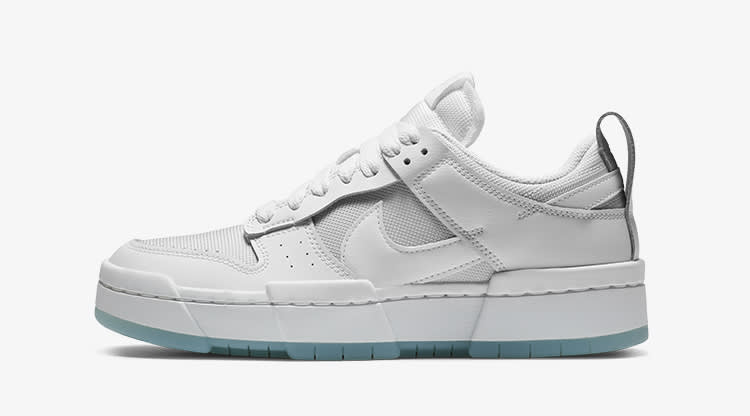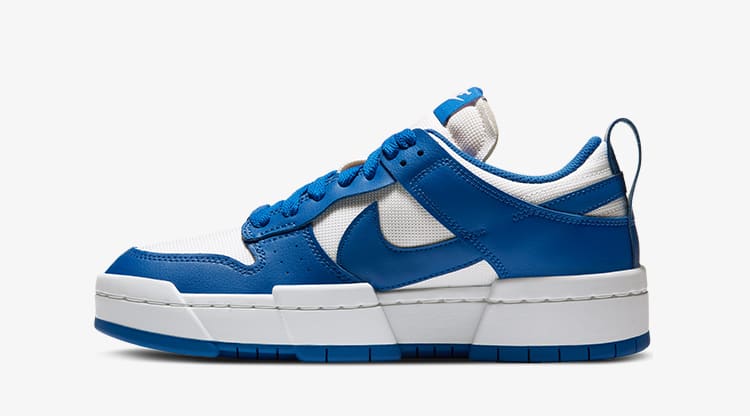Nike Disruptors: Kissing The Boys' Club Goodbye
3 September 2020To mark the launch of the Nike Dunk Disrupt we catch up with four female sneakerheads to talk community, opportunity, and resources for change
"So, did your boyfriend get you into sneakers?"
Over the past few decades footwear has evolved from no-frills functionality into one of the most prolific, impassioned, and profitable subcultures of modern times; giving birth to a community which balances on the very tip of what's new in footwear, music, fashion, and art - all defined by an inner sanctum of global tastemakers who predict trends more often than they follow them. But it's time to address the elephant in the room: the sneakersphere is a boys' club.
Enter: Alexandra Hackett (aka Miniswoosh), Tora Northman, Jess Lawrence, and Steph Morris. Four uniquely talented individuals who have battled uphill to carve a spot for themselves in an industry they love, marrying their passion and knowledge for sneakers with their professional and creative credentials.
Sitting down to talk candidly about their experiences as female talent in a male-dominated space, we hear first hand from the disruptors embodying the change the industry needs to mark the launch of the Nike Dunk Disrupt.
Alexandra Hackett | @miniswoosh | Creative Director @ Studio ALCH
What’s the best advice you’ve ever been given about making it as a female in the sneaker industry?
Alex: It’s not really advice, but I’ve always found the slogan ‘There is No Finish Line’ really motivating. It infers that there is no definitive ending — you have to keep pushing forward, learning new things and continuing the journey — and I think that applies to so many different areas of life.
Tora: To be myself and to not let anyone undermine my interests. Since I was a kid, my dad has told me, “take no shit,” and that’s definitely something I took with me when entering a very male-dominated space.
Jess: To view limitations as opportunities. Women continue to tackle sexism, a lack of representation and limited opportunities in the game, but we also have the power to change it. In the past decade we've come so far with sneakers and streetwear, from hyper sexualised images of women to sell products to now actually having a platform that focuses on our passions for sneakers rather than how we look. We have a long way to go, but I appreciate how far we have come too.
Steph: Not to pigeonhole myself as a female artist working in a male-dominated space. I have always been aware of the discrepancies, but I let my work do the talking. Be yourself and know your worth as an artist. Don’t limit your success because you have to stay in a preconceived ‘female’ lane. You should always break those rules.
What’s the one piece of advice you’d give to someone else trying to come up now?
Alex: Establish your point of difference and look outside of social media for inspiration — try to develop a style that no one else has, and really embrace it.
Tora: Don’t be afraid to ask for help. Unfortunately, there are a lot of people who don’t want to see others succeed out there, but I do see there being a better and more supportive community being formed within the sphere. It’s important to lift each other up, especially as women in this space, so reach out and ask for help and advice.
Jess: It's all about authenticity. If you are trying to make it in this industry but don’t have the passion, the time, the dedication, it won't happen. And if it does, it’s transparent and meaningless. Focus on what you love, perfecting your skill and passion, and the credit will come in due course. You can't fake it here among people whose passion is so evident. Plus, there are a lot of emotion and work tied up in sneakers: lots of Ls, lots of money, lots of micro-communities - you can’t be a part of that if you don't love it.
Steph: Be passionate. It makes the knock-backs easier to take and it’s a constant reminder why you’re on the journey.
Tora Northman | @toranorth | Editor @ Hypebae
Were there any resources available to you which helped in your journey in the industry? If not, what resources do you think would have helped?
Alex: I’ve always been inspired by women in sport and that determination to succeed, so that is really my fuel for success. I didn’t really feel there were that many resources for women in the industry 5-10 years ago, which is one of the main reasons my friend Meg and I decided to start our podcast “UK6”.
Tora: Honestly, not really. I think I found a lot of support from finding womxn with similar interests on Instagram, seeing that there was a growing platform for us to claim. When I first came into the industry a little over three years ago, I definitely feel like there wasn’t as much conversation about “women in streetwear,” but that has changed. The best resource is community and finding like-minded people you can lean on and draw inspiration from. I was lucky to work in a team consisting of solely women, and we managed to collectively make our voices heard and spark conversation.
Jess: Community is everything, other women in the industry really elevate each other, and without a solid network you'd really miss out on a lot of the joy. I think the resources to learn and improve are at your fingertips/on your phone. Follow accounts you admire, brands that inspire you, mood boards that engage you, practice your craft, and keep learning!
Steph: Making connections with the right people is key and the best tool for doing that is Instagram. It’s my digital gallery space and I can put my work in front of thousands of people instantly. With the growth of social media over the past decade you can pretty much DM anyone in the world. Definitely use that to your advantage.
Jess Lawrence | @jessylaw | Social Manager @ Vogue Business
Beyond the issues around size runs for big releases often not going below a UK6, what are some of the biggest obstacles which stand in the way of females investing in sneakers and how do you think the industry can combat them?
Alex: I think access to information and communication are some of the biggest barriers to entry, not only for women, but for all new entrants to the industry. Even after working in the industry for a number of years, I still enter raffles and accidentally order the wrong size or have difficulty predicting whether or not a style with sell out instantly. Luckily, over the years, we have seen incredible improvements in broadening the size range of so many styles, and we’ve seen some incredible women’s only lines and female-led collaborations.
Tora: I’ve always found that one of the biggest issues is the “shrink it and pink it” mentality that a lot of brands still hold on to. For women to like a shoe, it doesn’t always have to be super feminine, sometimes we really just want what the guys are getting. Another obstacle is not being taken seriously by a lot of entitled male “sneakerheads,” who frequently try to test how much you actually know about sneaker history. Such a snooze.
Jess: A perfect example of what is standing in the way of female’s investing in sneakers is the lack of support and dedication we get from the brands. We need more women-only releases, more campaigns for men’s releases which include women in the messaging and marketing. Throughout the whole process - design, manufacturing, leadership, marketing -it needs to come from women to represent women properly.
Steph: Firstly, attitude has to change. A lot of brands still think women just don’t ‘get’ sneaker culture or we don’t have the same knowledge. I know so many girls in the sneaker scene who are wearing more heat and have a bigger collection than guys. Secondly, improving accessibility. We need better access to female focused platforms which are curated for us specifically.
Steph Morris | @stephfmorris | Sneaker Artist/Illustrator
What does being a disruptor in a male-dominated industry mean to you?
Alex: I think being a disrupter means you’re challenging the status quo — whether that’s how you style your clothes and footwear or the type of artwork you create or even just your approach to the industry itself.
Tora: I like to challenge and start conversations. I think a lot of men are unaware of the lack of options for women in industries like sneakers and streetwear because it doesn’t directly affect them. In order to disrupt these mentalities need to be challenged and that can only change when pressure is applied. Being a disruptor also means recognizing that there's a need for a wider variety of voices within the community and supporting young girls and women that share my interests.
Jess: Being a disruptor in a male-dominated industry to me means simply not letting societal restraints get in the way of passion, success, and elevation. It means rising up and staying true to yourself despite setbacks and lack of opportunities. It means creating opportunities, building networks to inspire and elevate women and also representing the community by being just as good, if not better than our male counterparts.
Steph: It’s important to pass on the message to other women that you don’t have to be a guy to thrive in this industry. We are seeing so many amazing females shine in 2020 and that is something we need to celebrate and use as inspiration going forward.
Favourite swoosh silhouette of all time?
Alex: Probably the Air Max Plus — I absolutely love that gradient and the cultural following behind that model.
Tora: My all-time favourite release without a doubt is the COMME des GARÇONS x Nike Air Max 180.
Jess: Easy, Jordan 1
Steph: Cortez or Jordan 1.
The Nike Dunk Disrupt is now available on END. Launches.






















